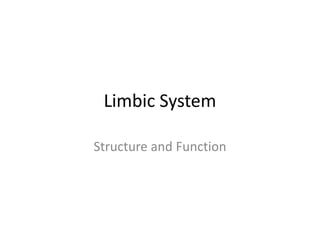
Limbic System
- 1. Limbic System Structure and Function
- 2. Outline 1) Neuroanatomy of the Limbic System 2) Circuits in the Limbic system 3) Functions of the Limbic System (plus HM and Kluver-Bucy syndrome) 4) Memory and amnesia- coming soon!
- 3. Of rabid dogs and neuroanatomists
- 4. Where is it? Limbic= border or edge (rim) 1) Medial aspect 2) Both Cortical and Sub-cortical structures 3) Involves parts of Frontal, Parietal and Temporal lobes 4) Highly interconnected
- 5. Cortical Components 1) Frontal= Orbitofrontal and anterior cingulate cortex 2) Parietal= Posterior cingulate cortex 3) Temporal= Parahippocampal cortex
- 7. Subcortical components 1) Hippocampus(partly) 2) Amygdala 3) Accumbens? 4) Septal and Basal nuclei
- 9. Hippocampus 1) Intimately related to the ventricular system 2) Continuous with fornix- the output network 3) Fornix moves posterosuperiorly, and at the splenium it curves forwards suspended by the septum pellucidum. 4) Reach the mammillary body and septal nuclei (of the hypothalamus)
- 12. Before we move on, 1) Where is the limbic system? 2) What are its cortical structures? 3) What are its subcortical structures? 4) Trace the course of the fornix
- 13. Amygdala and the rest Amygdala= Collection of nuclei in the entorhinal cortex, follows on from the tail of caudate nucleus Output= stria terminalis, runs on the ROOF of inferior horn of the lateral ventricle (cf fornix) Terminates in the hypothalamus and septal nuclei
- 17. Finally Accumbens nucleus= Terminal of mesolimbic pathway Septal nuclei= Under the septum pellucidum
- 24. Functions of the Limbic System 1) Reward and punishment, via being involved in memory and learning 2) The ‘survival police’
- 25. Action Memory and Evaluation Reward or punishment Learning Emotion Motivation
- 26. What do the bits and pieces do? As we said before 3 cortical components: 1) Orbitofrontal Cortex- Behaviour mods to avoid a future threat ie how to avoid negative stimulus. Involved in OCD. 2) Cingulate cortex- Anterior in two bits= rostral -> how to deal with pain, Caudal -> Quantify the severity (objectification) of pain. Posterior ?? Visuospatial memory? 3) Parahippocampal gyrus- Learning and memory!
- 27. Understanding function through dysfunction The Famous case of HM: Had medial temporal lobe’s removed -> lost all his parahippocampal cortex and part of amygdala on both sides. Post- op: Severe anterograde amnesia with preserved STM.
- 29. Lessons learned from HM Hippocampus is very important for memory, BUT not where memories are stored! Further studies, tell us that it allows for easy retrieval of memories and for proper transfer of experience into LTM. Also, not involved in learning or retrieving motor skills.
- 31. Kluver Bucy Syndrome Bilateral removal of amygdala in monkeys, made them bonkers. Further studies showed that: It complements the hippocampus in labelling of experiences by identifying their emotional component.
- 33. And finally, Septal and Basal Forebrain nuclei: Contain loads of Ach, project to the whole of the cortex, and are lost in AD. Their activity may allow strengthening of synapses/ consolidation of memory.
- 35. So, Hippocampus labels information wrt place & date Amygdala labels wrt to emotional component Basal and septal nuclei consolidate the information